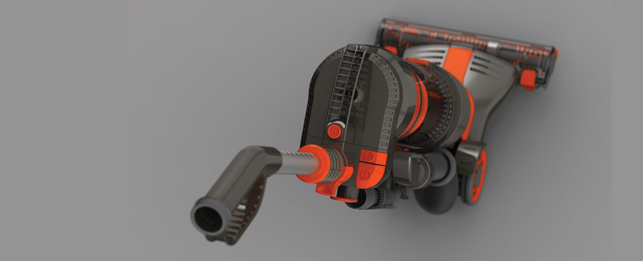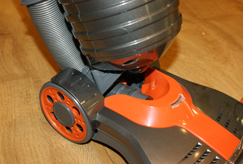Vax is a recognisable floor care brand to many Brits who immediately associate it with the iconic orange Vax-101 tub from 1980s.
Although the company’s heritage is in wet-dry carpet washers, today it’s the number one floor care brand in the UK by volume with around 100 appliances that sit within 11 ranges from upright and cylinder vacuums, carpet washers through to steam cleaners. From April 2010 to April 2011 it sold in excess of 1.1 million units.

Each component of the Air had to be scrutinised piece by piece in order to reduce weight but still maintain structural strength.
Vax is still based in Droitwich in the West Midlands where it was founded in 1979. There are nearly 200 employees onsite and although, like many other UK brands, production has moved overseas, Vax still considers itself very much a British company with all design and engineering taking place in the UK.
Given its output you would immediately assume that the design team is rather large, but in fact the exact opposite is true. “Considering the number of products we launch, the design team is smaller than you’d think,” says Mohammed Irfan, Vax’s design manager.
However, the reason the company is able to produce products at such a rate is down to the way the team is structured. Each designer takes complete ownership of a project and sees it through from concept to production. “But we don’t work in isolation.
Each of our multidisciplinary designers will have their particular key strengths, which we then pull into the projects at various phases in the development cycle. It means that we can have a very lean team and a lot more throughput,” adds Irfan.
Making light work
A project that Irfan had responsibility for from beginning to end was the Air. Launched in late 2009, this multi-cyclonic upright vacuum, with the air power of a full size machine, has all the features of a conventional vacuum but, as its name suggests, comes in a slimline and compact package.
It weighs in at 4.9kgs and compared to a machine of similar size, about 5.5kgs has been stripped out of it without compromising performance or durability. Like all of Vax’s premium lines, it has a six year guarantee and, since its launch, has been a great success story for the company, now spearheading the ‘Air’ product range. “It was a very challenging project and I’m really proud of it,” smiles Irfan.
The idea for Air came from listening to the customer, something that Vax pays a great deal of attention to as customer feedback often feeds directly into new designs. “There was a very clear need in the market – people wanted a lightweight machine that could do the job of a full size one,” says Gavin Burnham, senior designer at Vax.
However, vacuums are big for a reason as they house big motors and various features and functions. “Saying you want to make something lightweight is great to put down in a brief but the challenge was to still have full capacity and, most importantly, full performance,” he adds.
Getting hands dirty
Knowing what the various specifications and requirements were for this upright vacuum, the project kicked off in the workshop where a rough card model was put together using existing components from old machines. “One of the things that we do very early on is to get into the workshop, get our hands dirty and build some things together. This helps us to see what works, what doesn’t and what ideas we can come up with,” comments Irfan.
So, with a bin taken from an old machine, a motor housing from somewhere else, a handle from a recent model and some cardboard, a rough spatial model is built up. It was also at this very early stage that Irfan realised that instead of using a heavy, bulky floorhead he had the opportunity to use an existing lightweight prototype that had been sitting on the shelf for sometime without being used.
“With these early models, you can wrap card around them, pull them apart, scribble on them, you can get people involved and all of a sudden they become a really interesting focal point to generate ideas and develop to the next level,” he says.
The next step was to create a functioning breadboard model to see whether the technology could all work together. Each of the components would be looked at individually later on in the development process but, for now, Irfan concentrated on the technology. Drawing on previous experience together with trial and error, a number of models were built up and tested until the team got something they were happy could meet the brief.
Simultaneously, sketches were being created in order to design the visual brand language. “We wanted this machine to look cool, to look sexy. Well, cool and sexy for a vacuum cleaner…,” laughs Irfan. The sketches were brought into Pro/Engineer and the CAD built over the top of them in order to start creating the layout. This process of working simultaneously in the workshop, in sketch and in CAD carried on throughout the project. “Sometimes we find that the CAD side of things highlights something and we have to go back to the workshop or vice versa,” adds Irfan.
One engineering challenge that only surfaced once a number of prototypes had been built was the design of the yoke. This single piece component at the bottom of the machine pivots the main body from the floorhead and has the main air hose and wiring for the electronics going through it.
“The biggest challenge was how do we make this manufacturable as well as functional and strong and lightweight because at the end of the day it also has to be tooled effectively and efficiently,” explains Irfan.
In the early drop tests this pivot mechanism actually broke and resulted in the whole machine failing. Members of the design and R&D teams were pulled in to work on it. “It was very challenging. The CAD gave me a massive headache,” says Burnham, whose speciality in the team is his proficiency of Pro/E.
“First of all it’s coming up with an initial shape in CAD that firstly, looks as though it may work within the space available and, secondly, has some chance of being tooled. We knew we wanted to keep it as one component because splitting it in two would reduce the strength. So, once we got the initial shape, we then had to look at where the air path could go and how to get additional strength underneath by putting ribs in. It took a while,” he adds.
Weighty issue
As with the yoke, each component of the Air had to be scrutinised piece by piece in order to get the weight down but still ensure that the machine could uphold the six year guarantee. This proved to be a massive balancing act for Irfan who had countless spreadsheets with information regarding weight.
“It was literally down to the gram, and different configurations meant we had to do things in different ways. So saving a few grams in one area may have a knock on effect on another,” he explains. “We really had to analyse everything throughout the entire process up to how it would be manufactured and assembled and then play all these scenarios out. It was quite involved.”
There were ways in which weight could be reduced from various components. For instance, the handle has an open lattice structure, to reduce the amount of plastic. Other components also feature holes, gaps and recesses but only in areas where it doesn’t affect the structural strength.
Material matters
Another means of weight saving was for components to perform multiple functions as this lessened the number of fasteners and fixings needed. As well as considering the weight of different materials, the way in which they would be painted and finished also had to be taken into account as paint adds weight too.
“Every component and every material that we chose also had to be understood from an aesthetic point of view just to make sure we get the right colour matches and the right quality of finish,” comments Irfan.
With the Air taking shape and the aesthetics having been further refined, a full-scale block model was prototyped. This was outsourced to a company in China who used CNC to create the model out of painted ABS and clear PMMA, which was then polished for optical clarity. Although Irfan did look at companies in the UK, no one could meet them on time or cost.
The impressive block model helped to really sell the Air into the business and although the design did evolve subsequently, at the time it captured everything that they wanted and helped build some excitement around the product.
The next stage in the development was the detailed design phase where individual components were analysed and tested before a fully functioning model could be developed. Together with computational fluid dynamics and structural analysis, prototypes of the components were also built and physically tested. This involved a constant process of building, testing and refining.
Once Irfan and his team were happy, the CAD files were sent over to the manufacturing partner in China, with whom they have worked for many years. However, it isn’t a case of just handing the files over to them, there is constant communication between the design engineers at the factory and the designers in Droitwich to ensure that the design is completely to Vax’s requirements.
“During the detailed design phase we have daily conversations with the factory engineers to make sure that we have complete control and ownership of the product,” stresses Irfan.
Once the tooling has been completed, off-tool sample parts and fully assembled machines are then vigorously tested for performance and reliability before committing to mass production. With access to extensive testing facilities tests are carried out on individual parts and full machines in cycles numbering into many thousands.
“We have a huge number of test protocols that we have to pass. We intentionally break everything that comes off tools to see exactly where our potential issues are and then for the next three to four months we are working on ensuring that these are eliminated from the final product “ says Irfan.
In the meantime, the final CAD data is also being used to create photo-realistic product images, which helps to create a buzz around the product before it even emerges from the assembly line. These renderings, created in KeyShot, are used for the product packaging and marketing material including brochures, posters and press releases.
Clean sweep
In a little over a year from the start of the project, Air was officially launched in October 2009. It received great reviews from the press as well as customers who liked its powerful, lightweight design at a price that was competitive. The next product in the range – Air Reach with extended hose and cable length – came directly from customer feedback and features a total cleaning reach of 15 metres. Since then the Air Pet and the bigger Air Force have followed.
The latest in the range – Air Cylinder – was launched during July 2011 in conjunction with a new marketing campaign. As well as a redesigned logo, Vax has updated its tagline to ‘Performance is everything’, relating to the company’s focus on product design, production and customer care.
Having come a long way from the company that only produced orange tubs, Vax continues to innovate with Irfan hinting that there are some very interesting things currently in development. “One thing is to not be complacent – we’ve done a lot and we’ve come along way. We have to continue to develop and learn.”
www.vax.co.uk

The development of Vax’s super lightweight, high performance vacuum, the Air
Default








